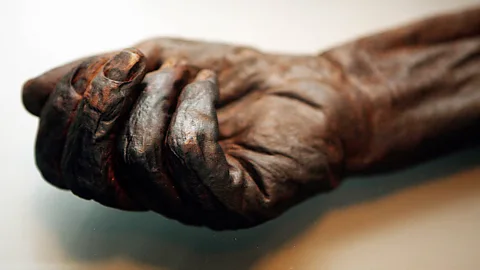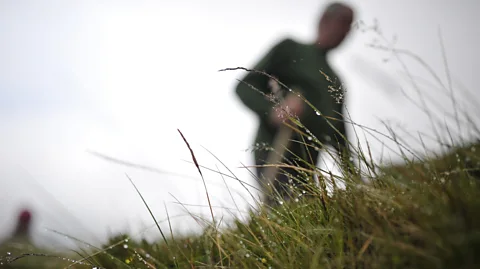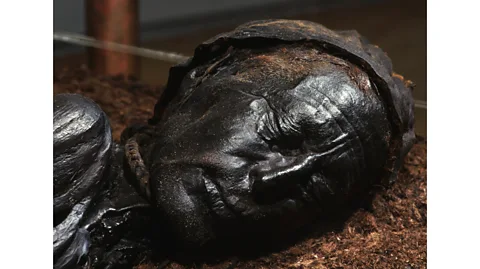The mystery of the human sacrifices buried in Europe's bogs
 Alamy
AlamyUncannily well-preserved bodies from the ancient world occasionally surface Northern Europe's bogs. Stranger even than their remarkable preservation is the disturbing manner of their deaths.
The solid, rounded object Andrew Mould found buried in peat at a bog called Lindow Moss in Cheshire, north-west England, put him in mind of an old-fashioned leather football. But a closer look revealed it to be something far grislier.
This article contains references to murder, ritual sacrifice and suicide.
"We cleaned it all up and we knew it was a skull," says Mould. It even contained a yellowish substance which, he learned later, were the remains of the brain.
Finding human remains in the bog didn't come as a complete surprise – for centuries there had been accounts of body parts turning up in bogs similar to Lindow Moss across Northern Europe. Peat-cutting was Mould's family trade – many of his male relatives worked on the bog, and Mould had been going to Lindow Moss since he was a child to watch his father cut peat. Mould had read about these cases before, and he'd found "bits and pieces" himself in the course of his work, but this was something new.
So Mould did what most would, and went to the police. It was May 1983 and for more than 20 years the Cheshire Constabulary had suspected a local man Peter Reyn-Bardt of murdering his wife Malika de Fernandez, but her body had never been found. A body, or part of one, turning up in the bog nearby could at last close the case.
When the Cheshire Constabulary told Reyn-Bardt that a woman's skull had been unearthed in Lindow Moss, he confessed to killing his wife. "It has been so long I thought I would never be found out," he told the investigating officers.
What Reyn-Bardt didn't know was that the skull didn't belong to his deceased wife at all. In fact, it belonged to a woman who had lived some 1,600 years earlier. And so as the police closed one cold case, archaeologists opened another, much colder one.
You might also like:
In the acidic, low-oxygen watery depths of the bog, bacteria and other microorganisms aren't able to break down organic tissue, effectively suspending biological remains in time for thousands of years. (Read more about how bog plants prevent decay.) In the case of Lindow Woman, as she came to be known, the bog had even preserved one eyeball as well as her brain.
There are many others like her. Across Northern Europe, the same process that turns sphagnum moss into peat has turned human remains into bog bodies. These people were interred in bogs as far apart as Ireland and Germany, from as early as 2000BC (though even earlier bog skeletons without surviving soft tissues have been found dating from 8500BC).
Archaeologists suspect there is something unusual about many of the bog bodies, beyond their extraordinary preservation. To be buried at all during this period of history was not the norm – formal burials were rare in Iron Age Europe, with the dead often cremated, given sky burials or a range of other inventive practices. Many of the bog bodies were young adults, adolescents and children, who seemed to be largely fit and healthy. Some were naked except for a well-preserved piece of rope, a hat or a cloak, and sometimes their clothes were buried separately from them nearby in the bog. Above all, many of the bodies had suffered extremely violent deaths.
As the methods to forensically examine the bog bodies have advanced rapidly in recent years, the mysteries of the bog bodies, and who they were in life and death, are beginning to unravel.
 Getty Images
Getty ImagesAfter Lindow Woman, another chance discovery in the same stretch of peatland helped reshape the study of bog bodies in Europe. The discovery was made by a now-familiar figure – Andrew Mould again.
The summer after he found Lindow Woman, Mould was working at the conveyor belt of the peat milling machine when a dark, solid lump fell off the belt at his feet.
"We thought it was a piece of bog wood at first," Mould says. When he picked it up, it felt like the leather of a handbag. He showed it to his friend and co-worker. "Then we gave it a little clean, and we saw the toenails."
In the days that followed, an entire head and torso were carefully excavated (though on this occasion the Cheshire Constabulary solved no more cold cases). At the British Museum, the body was found to be that of a man in his mid-twenties, roughly 1.73m (5'8") and 64kg (140lb), who lived around the 1st Century AD.
"What was spectacular about him was that he was almost killed three times," says Miranda Aldhouse-Green, emeritus professor in the School of History, Archaeology and Religion at Cardiff University and author of the book Bog Bodies Uncovered. "He was given a very special protracted death by people who understood human anatomy: he was hit on the head hard enough to stun him, but not kill him. He was then garrotted, and at the same time, his throat was cut."
 Getty Images
Getty ImagesWhy such a brutal killing? The excessive violence used to dispatch Lindow Man points to something far more unusual than an "ordinary" murder, says Aldhouse-Green.
Sacred places
To understand bog bodies' fates, you first have to understand the bog in Iron Age and Roman Era Europe.
"We see the bogs as empty places," says Melanie Giles, senior lecturer in archaeology at the University of Manchester, and author of Bog Bodies: Face to face with the past. "That's not how Iron Age people saw them. They were taking fuel from the bog, cutting turf, taking iron ore. They were making tools and weapons like cauldrons and swords. They were taking sphagnum moss and weaving extraordinary things with it. They were hunting the bird life that lived there. The bogs were rich and productive places for Iron Age people."
And then there is the fact that the bog is a borderland, somewhere between land and water. "I think the bogs themselves are also very special, because they are miasmic. They've got vapours coming off them, which sometimes spontaneously combust. They can be smelly. They look like land, but they're not land," says Aldhouse-Green. "They were possibly perceived as being gateways to the other world and gateways to the Gods."
Even today, the raised bogs can be mesmerising, says Ole Nielsen, director of the Silkeborg Museum in Hovedgården, Denmark. "It doesn't really take a lot of fantasy to imagine that there are more forces going on than you can really see."
 Getty Images
Getty ImagesFrom careful analysis of the surroundings of the site where Lindow Man was found, he was most likely alive when he entered this liminal environment for the last time, says Giles. By using Geographic Information System (GIS) data to map the bog, researchers have found that Lindow Man was buried in the deepest part. Manoeuvring a dead or stunned person to such a location would have been extremely difficult over such treacherous ground. "Because it's so dangerous going out there at that point, he's probably alive when he goes," says Giles.
The details of his fatal injuries also points in this direction. "The perpetrator was very knowledgeable about human anatomy, and knew how to keep this person hovering on the edges between life and death for quite some time," says Aldhouse-Green. "When he was then thrust face down into the bog, he was still breathing, because there is water in the lungs."
Last meal
Further clues come from Lindow Man's stomach. Painstaking analysis of his last meal reveals an underwhelming barley-based meal, possibly a little charred. "The last thing he ate before he died was really rather plain food," says Sophia Adams, curator of the European Iron Age and Roman Conquest Period at the British Museum. "He's eating what they call a griddle cake."
The late Celtic scholar Anne Ross, who did influential early work on Lindow Man, argued that this griddle cake, made from barley and partially burned, reveals something of his fate. Amongst the priestly classes of Britain in this era, griddle cake was used in a ceremony much like taking the short straw. People would pull pieces of griddle cake from a bag, and the one whose piece was charred and burnt was chosen to be a scapegoat.
Other bog bodies tell of unusual last meals too. One Danish body known as Grauballe Man is that of an Iron Age farmer who lived in around 390BC in central Denmark. His last meal involved more than 60 different types of plant, mashed together in an unpalatable porridge of cereals, bitter-tasting weeds and more than 13 species of grass.
"You've got lots and lots of seeds and plants from quite a wide area gathered for this meal, which suggests mastery over that territory, and it suggests that was being ritualised and represented in the sacrifice," says Aldhouse-Green. "But there are all sorts of ways you can interpret this last meal. It could also have been a humiliating meal."
Lindow Man's griddle-cake meal also contained a tell-tale trace of another plant: mistletoe. Ross argues that this suggests a connection with the ancient Druids, who were known to perform mistletoe-gathering rituals. Aldhouse-Green points out that it was known in antiquity as a medicinal plant for nervous disorders, and it "may have been given to Lindow Man to calm him and to render him more amenable to his terrible death".
 Alamy
AlamyGrauballe Man, too, had a psychoactive substance added to his final meal, though in his case it would likely have been anything but calming. Traces of alkaloid toxins in his gut revealed that his last meal included ergot, a fungus that grows on ears of cereals such as rye and barley. At large doses, ergot poisoning causes hallucination and horrific effects known as St Anthony's Fire, involving circulatory failure, a burning sensation, and loss of extremities from gangrene. At the levels found in Grauballe Man's stomach, it would have had a milder effect.
Distinguishing features
Among the bog bodies discovered, there is an over-representation of people with physical differences that may have stood out among their community, says Miranda Aldhouse-Green.
For instance Yde Girl, who lived 2,000 years ago and died at the Stijfveen bog in the Netherlands, had pronounced curvature of the spine, which would have caused chronic pain and likely given her a lurching gait. Another Dutch bog body from the same era, Zweeloo Woman, had a form of dwarfism. In the UK, the third ancient body found in Lindow Moss (known as Lindow III) possessed a vestigial second thumb on his right hand.
"There is a possibility that disability was not exactly celebrated, but marked as being special and powerful, and possibly associated with being touched or blessed by the divine," says Aldhouse-Green. But, she stresses, we cannot be sure how physical differences were perceived in antiquity, and such theories remain speculative.
"That might have caused him to behave very oddly as soon as he ingested it," says Aldhouse-Green. "It would have made him make weaving movements. It would have made him very hot, it would have made him cry out. He would be in the throes of an extreme psychotic phenomenon, and so possibly that was part of the preliminaries for the sacrifice."
Ritual death
Perhaps the best-preserved face from all the ancient world is that of Tollund Man, a bog body found in Denmark in May 1950. Today, Tollund Man lies in a foetal position at the Silkeborg Museum. Like many bog bodies, the bog acids have turned his skin a blueish-black colour and his stubble and hair bright orange, though he wears a sheepskin cap that covers most of it. Every fine line, almost every pore of his skin is visible, and his wrinkled eyelids are closed, giving the illusion of a peaceful sleep.
"You can really meet this person," says the Silkeborg's Nielsen. "The face is the body part that has most expression of the human body. And so this is really fascinating to meet an Iron Age man, more than 2,000 old, that looks as if he could wake up at any moment."
Aside from his sheepskin cap, Tollund Man was buried wearing only a woven belt around his middle and a noose around his neck.
"If he had any woollen garment on, it would have been preserved, no doubt," says Nielsen. The bog acids preserve collagen and keratin, which are present in materials like wool. "His hair is still there, and his nails are there."
Neither is there any imprint of cloth on the surface of Tollund Man's skin. "We have really examined his body very, very carefully with microscopes. There are still many, many leaves of sphagnum moss to be seen on his body, but nothing indicating that he had anything else on. So he probably was put down like we see him. It's really, really peculiar to see him naked and with a cap."
 Getty Images
Getty ImagesIn all, Tollund Man's condition points to a ritual death. "For the sacrifice, he was shaved, and he was put in the bog with the hanging noose," says Nielsen. Leaving the noose with the body is conspicuous, he believes, as even something as simple as a woven piece of rope had value and could be used again. "It was probably left as a sign," says Nielsen. "His task was to be put in the bog because he had that purpose. Whether he was a volunteer, or maybe he drew the short straw, we don't know. But he doesn't look that uncontented."
Godly gifts
The idea of going willingly to such a gruesome death is a hard thing for a 21st Century mind to grasp, but it may not have been so outlandish to those living through the Iron Age.
Exhibition ethics
Bog bodies in Europe have often been displayed in museums after their excavation and careful preservation.
However, controversies have arisen from the public display of the bodies. One touring exhibition in Ottawa, Canada faced backlash for display of the human remains.
Melanie Giles of Manchester University argues that thoughtful display of the remains can help create intimate emotions and social bonds between bog bodies and those who engage with them.
"We need to think of a world in which the gods were everywhere. So everything you do is associated with the gods," says Aldhouse-Green. As such, keeping the gods happy may not only have been life and death for individuals, but whole communities. "If you annoyed the gods, they would give you a bad harvest, or give you a pestilence, or the crops would fail, and so on. And so you had to keep them on side."
Giles agrees. "You're dealing with entities that are influencing your life, gods or spirits, there's something supernatural there that can be accessed though the bog," she says. There may have been an element of circularity to the offering of people to the gods via the bog, Giles adds. "As people were taking so much from the bogs, they seem to have been compelled to give things back." Sometimes these things were cauldrons, sometimes they were food offerings such as bog butter. "If you give up a person, a life – that could be the very best kind of offering you can make."
But while there is evidence that Lindow Man, Tollund Man and Grauballe Man and others were human sacrifices, we shouldn't assume all bog bodies were, Giles cautions. For some bodies, such as Lindow Woman, there simply isn't enough of them left to put together a convincing picture of how they died.
"There are some bodies that show no signs of violence and these people may simply have drowned," she points out. "These are dangerous landscapes. People die on the bog – they die of exposure, they die trying to cross it, they lose their footing or misjudge where they're walking. Some of these would have been accidental deaths."
Others, she says, may have been simple murders. Perhaps a deserted bog was sometimes simply a convenient place for nefarious deeds. There may also have been victims of suicide among the dead, who were perhaps placed there at a time when such deaths were treated with fear rather than empathy.
"The bogs might have been seen as the right places to put a dangerous body – someone who has died mysteriously or unnaturally," says Giles. "Some of that was to do with the Church saying they don't want those people in its graveyards. Some of it is that the bog is a powerful place beyond human reach where those dead can be contained."
--
Full disclosure: Researching bog bodies for this story led to more than one surprise for the writer, including discovering that one of the world's leading experts on them is a relation. In the interest of transparency, Miranda Aldhouse-Green is the writer's first cousin once removed.
--
Martha Henriques is Editor of BBC Future Planet, and tweets at @Martha_Rosamund
--
